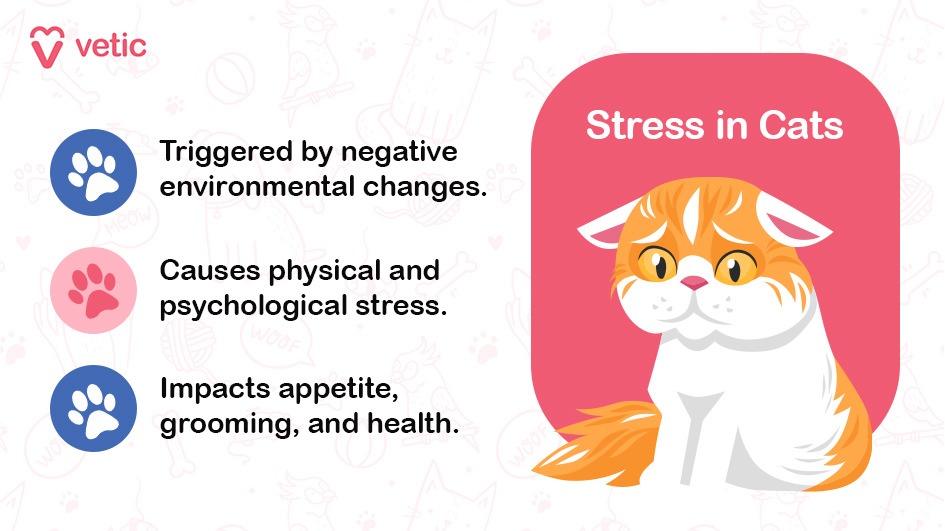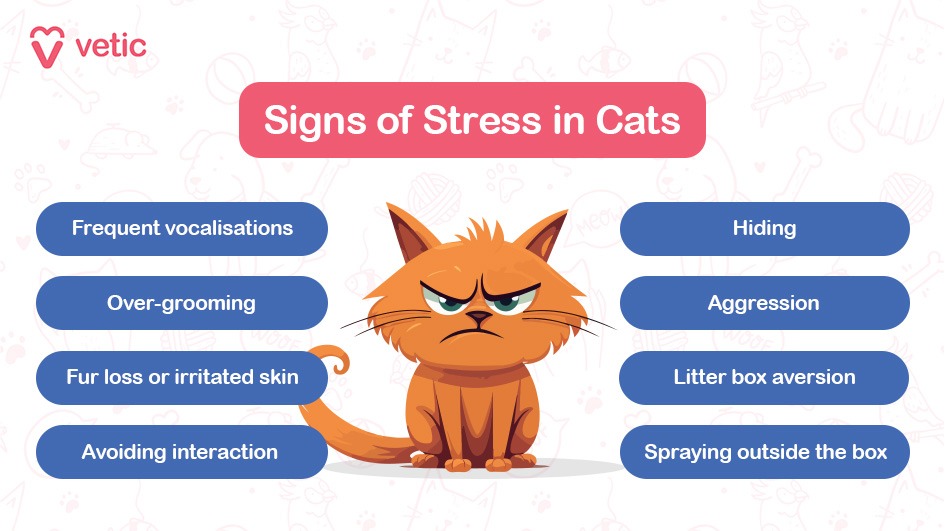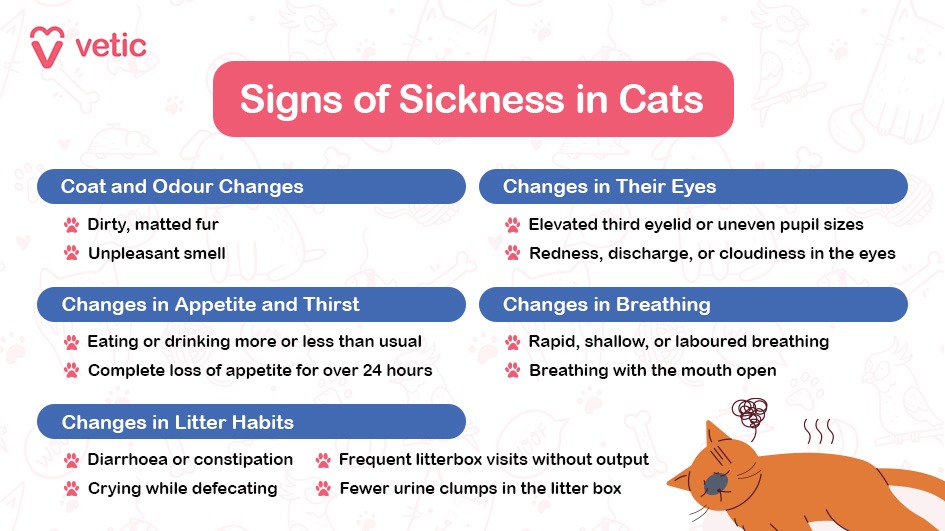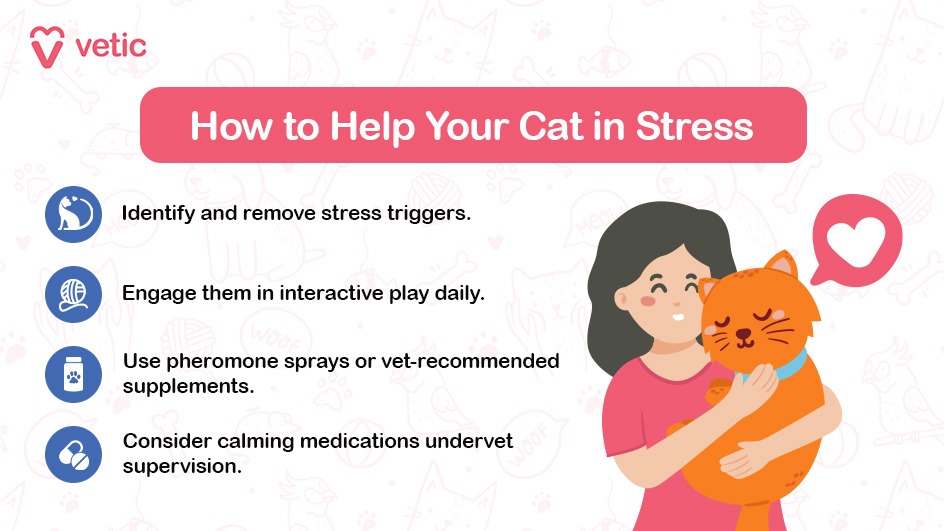For years, cat specialists and cat behaviourists have been trying to relate lethargy, stress and sickness in cats. A study published on JVAMA in 2011 shows that stress in cats can not just mimic signs of sickness, but also cause actual sickness. This begs the question many pet parents ask, “Is my cat lethargic, stressed or sick?”
Cats are private and complicated, and that’s simply not debatable. Small things like moving the furniture around, changing the quality of their litter overnight or moving their food bowls can induce stress.
So, how do you understand if your cat is stressed?
What is Stress in Cats?

Cats are capable of complex emotions including fear, boredom and even stress. The psychological and physical stress can be caused by negative environmental stimuli. Changes in their environment including the movement of their belongings, and the introduction of new individuals, can cause changes in their appetite, thirst levels, litter box use, grooming habits, coat health and digestive system health.
Signs of Stress in Cats

Here we will discuss the signs of stress in cats. However, many of these signs are also present in sick cats. So, if you see multiple signs in your cat, it’s best to talk to the veterinarian since they may be displaying signs of sickness in cats.
Frequent Vocalisations
During stress, cats can mew more, yowl or even hiss at the smallest causes. Hissing and growling become common when there’s the introduction of new and unknown elements in their environment including new humans, babies or cats.
Frequent mews and yowls can be signs that your cat is feeling scared or in pain. Speaking with the veterinarian is important especially if there have been no changes made to their environment.
Increased Grooming
Cats often groom themselves more frequently and obsessively when they are stressed. They will spend more waking hours grooming their fur resulting in patchy hair loss and irritated red skin. It may lead to more frequent hairballs and vomiting.
If you suspect your cat is under stress, check their inner legs, belly and chest. You may notice thinning fur and redness. In such cases, you will need to speak with your veterinarian for supplements that can reduce the stress and include more interactive activities with your cats in your daily schedule.
Hiding
Cats in stress will often spend more time hiding under sofas, beds or even inside wardrobes. Although a number of cats show aggressive behaviour in response to threats, some cats simply choose to avoid all interactions with pet parents and other pets.
However, don’t try to disturb them or pull them out of hiding, since that can increase the stress. Leave food and water out for your cat near the hiding place within their reach.
Aggression
A significant number of cats hiss, bite, scratch and growl when they are threatened. They show the same behaviour towards even their pet parents when they are stressed.
During such situations it is best to not scold them or meet their aggression with aggression. Aggression can have multiple causes besides stress, so you must speak with your veterinarian before you begin any calming supplements or medication.
Litterbox Aversion
Avoiding the litterbox is common among stressed cats. They may hold their urine for hours, go right outside the litterbox or spray on walls, furniture and other vertical surfaces. It is an act of territory marking which comforts the cats.
However, such behaviour is also seen in cats with UTI, bladder stones and kidney stones. So, if your cat has not been peeing longer than 24 hours or going outside the litterbox repeatedly, you MUST speak with your vet.
Lethargy
Cats can sleep for 16-20 hours every day. However, if they are sleeping for longer, refusing to engage in play or just laying in one spot grooming themselves when they aren’t sleeping, they can be considered lethargic.
Lethargy in cats or low energy is a telltale sign of stress. Nonetheless, stress can only be concluded as the cause if environmental factors are present and physiological factors are absent.
Loss of Appetite and Thirst
Low activity levels often accompany loss of appetite and water intake. It can happen because of high levels of cortisol or the stress hormone.
High cortisol levels may also cause nausea which leads us to our next sign of stress in cats.
Vomiting and Diarrhoea
High cortisol levels can cause nausea and vomiting in cats when they are stressed. Stress can also cause inflammation in a cat’s gut, which can lead to diarrhoea.
If your cat is showing signs of chronic diarrhoea, you definitely need to visit the veterinarian. They may not require antibiotics, but they may require supplements to settle their gut biome.
Pacing and Spraying
It is a common sign of stress among indoor cats when they are stressed. The pacing often occurs during their waking hours and is accompanied by yowling or spraying.
Although spraying is an activity common among intact male cats, even neutered male and spayed female cats can spray on vertical surfaces out of stress. Constant pacing can cause a spike in your cat’s body temperature and lead to further complications such as appetite loss and hiding.
Rapid Breathing and Panting
Cats can pant just like dogs during times of severe stress, such as visiting the vet. However, the panting should stop as soon as the external stimulus of stress is removed.
Cats also show signs like rapid and shallow breathing during times of duress. Often, using cat pheromones, speaking to them in a soothing voice and addressing the cause of fear/stress reduces these signs.
Changes in The Eyes
A stressed or fearful cat often has their pupils fully dilated. Full dilation of the pupils allows more light (and information) to enter their eyes and brain. It is a way for them to take all the new elements in their environment for processing.
If it is not accompanied by any discharge, redness or elevation of the third eyelid, it is quite normal. Once your cat adjusts to their new surroundings or you take them back to their familiar places, their anxiety and stress will reduce and their pupils will return to their usual size.
How to Tell If Your Cat is in Stress or Sick?

In reality, telling sickness apart from stress in cats is quite difficult. Even sick cats show almost all the behaviours mentioned above. However, you may notice some additional signs –
Coat and Odour Change
All cats have a strong sense of smell. It causes them to groom themselves regularly and keep themselves clean. Depending on the type of sickness, your cat may either be unable to reach certain parts of their body or simply be too dehydrated to clean themselves.
A sick cat’s coat is often dirty, matted and they may even smell unpleasant from the lack of hygiene. It is a definite sign that the cat is too sick to care for themselves and requires veterinary care.
Changes in Appetite and Thirst
Sickness can cause your cat to eat more or less depending on their condition. They may quit drinking water altogether or drink too much. For example, hyperthyroidism and diabetes mellitus can cause your cat to eat and drink more. CKD in cats can cause loss of appetite with increased thirst.
Some cats are naturally picky eaters, but if your cat isn’t one but they are showing disinterest in their regular diet it can be cause for concern. If your cat hasn’t eaten in longer than 24 hours, you need to take them to the veterinarian for a checkup and complete blood test.
Changes in Litter Habit
Cats can show signs of diarrhoea or constipation when they are sick. Hyperthyroidism, liver and pancreatic issues can cause diarrhoea. On the other hand, any disease that causes dehydration can lead to severe constipation.
A constipated cat may visit the litterbox frequently and may even cry out while defecating. Keep an eye out for urine clumps in the litter box. If they are fewer than the normal amount, speak to your veterinarian ASAP.
Changes in Their Eyes
During stressful conditions, cats often dilate their pupils to take in as much information as possible from their surroundings. That is quite normal in new environments. However, if your cat has other signs such as an elevated third eyelid or different sizes of pupils in either eyes, it’s ti,e to go to the veterinarian.
Changes in Breathing
A sick cat or one in pain may have trouble breathing. They may take rapid and shallow breaths and they can breathe with their mouth open.
Check their posture (extension of their head and neck) to understand if the cause is psychological or physical. Nonetheless, breathing problems demand immediate attention from a vet.
Is Your Cat Stressed or Sick?
The signs of sickness in cats can be quite similar to stress in cats. To distinguish, you may want to observe them for a short period of time (8-10 hours) since the onset of the signs. If your cat continues to not eat, drink, urinate or defecate for 24 hours, you must treat it as an emergency.
These situations often require blood tests and other tests that can help the veterinarian understand the underlying cause of the signs.
At the same time, if your cat is indeed stressed for a long period of time, they will fall sick unless you invest time and effort to make them feel safe and comfortable.
How to Help Your Cat in Stress?

You will need to spend more time with your cat. Try removing the cause of stress, undoing the changes and try to engage them in interactive activities.
You can also try calming cat pheromone sprays in your home near their sleeping and playing quarters. You may want to speak to your veterinarian if your cat suffers from chronic stress since CBD as well as some other supplements can help your cat feel calmer and more relaxed.
Cats do suffer from anxiety disorders. However, treating that with medication requires rigorous observation and testing. Some select medicines help cats overcome their anxiety and signs of stress. Your veterinarian may be able to help you find something suitable for your cat’s age and health status after careful examination.

